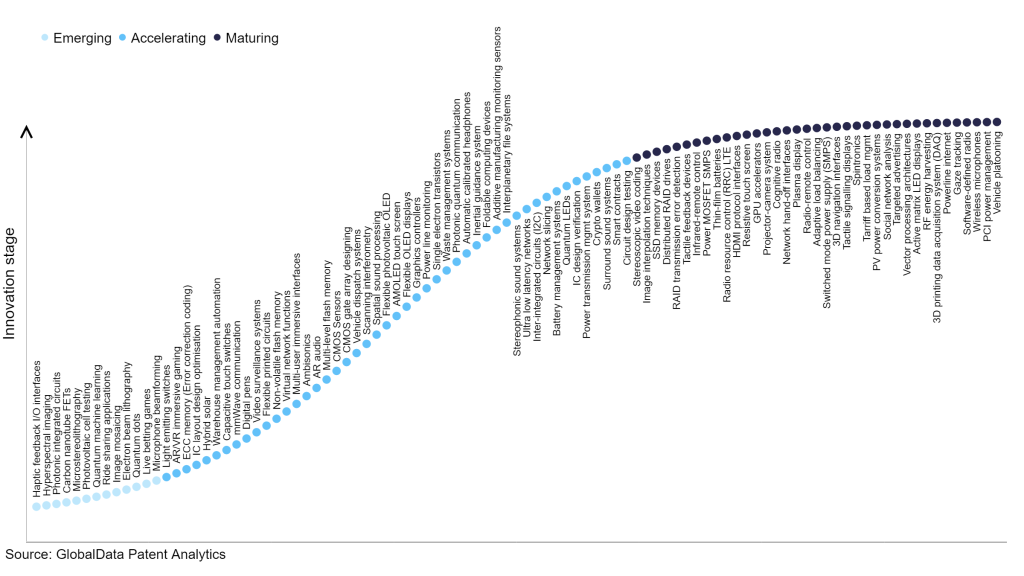The technology industry continues to be a hotbed of innovation, with activity driven by the increasing demand for premium audio solutions, advancements in audio technology, and the rising popularity of home entertainment systems, and growing importance of technologies such as dual-channel audio processing, signal amplification, speaker design, and audio encoding formats such as stereo PCM (pulse-code modulation) or Dolby Digital. These technologies work together to provide a rich and realistic audio environment, making stereo systems a preferred choice for music enthusiasts, home theatre setups, and professional audio applications. In the last three years alone, there have been over 3.6 million patents filed and granted in the technology industry, according to GlobalData’s report on Technology Innovation: Stereophonic sound systems. Buy the report here.
However, not all innovations are equal and nor do they follow a constant upward trend. Instead, their evolution takes the form of an S-shaped curve that reflects their typical lifecycle from early emergence to accelerating adoption, before finally stabilising and reaching maturity.
Identifying where a particular innovation is on this journey, especially those that are in the emerging and accelerating stages, is essential for understanding their current level of adoption and the likely future trajectory and impact they will have.
300+ innovations will shape the technology industry
According to GlobalData’s Technology Foresights, which plots the S-curve for the technology industry using innovation intensity models built on over 2.5 million patents, there are 300+ innovation areas that will shape the future of the industry.
Within the emerging innovation stage, microphone beamforming, live betting games, and quantum dots are disruptive technologies that are in the early stages of application and should be tracked closely. Circuit design testing, smart contracts, and surround sound systems are some of the accelerating innovation areas, where adoption has been steadily increasing. Among maturing innovation areas are vehicle platooning and peripheral component interconnect (PCI) power management, which are now well established in the industry.
Innovation S-curve for the technology industry

Stereophonic sound systems is a key innovation area in technology
Stereophonic sound systems utilise multiple audio channels to deliver a heightened and immersive auditory experience. By employing two or more speakers, with each speaker dedicated to a specific audio channel (left or right), these systems create a sense of depth and direction in the sound. This three-dimensional soundscape enhances the listener's perception, allowing them to immerse themselves in a fuller and more realistic sound environment.
GlobalData’s analysis also uncovers the companies at the forefront of each innovation area and assesses the potential reach and impact of their patenting activity across different applications and geographies. According to GlobalData, there are 40 companies, spanning technology vendors, established technology companies, and up-and-coming start-ups engaged in the development and application of stereophonic sound systems.
Key players in stereophonic sound systems – a disruptive innovation in the technology industry
‘Application diversity’ measures the number of different applications identified for each relevant patent and broadly splits companies into either ‘niche’ or ‘diversified’ innovators.
‘Geographic reach’ refers to the number of different countries each relevant patent is registered in and reflects the breadth of geographic application intended, ranging from ‘global’ to ‘local’.
Patent volumes related to stereophonic sound systems
Source: GlobalData Patent Analytics
Nokia is a leading patent filer in the field of stereophonic sound systems. One of the company’s patents describes methods, devices, and software products used to deliver 3D audio playback through head-mounted devices. These devices can receive position and orientation information from the user's head-mounted device and use it to train a machine learning model. Signal quality parameters are determined based on input data, and filter pairs are selected based on the spatial direction to render the audio signal. This allows for dynamic control of the spatial audio signal reproduction based on changes in the position and orientation of the head-mounted device during playback.
Other prominent patent filers in the space include Dolby Laboratories and Sony .
By geographic reach, Dolby Laboratories leads the pack, followed by ARKAMYS and Koninklijke Philips. In terms of application diversity, Shenzhen Voxtech holds the top position, followed by RoundGlass and Bandai Namco.
Stereophonic sound systems can create a more immersive and realistic listening experience. By utilising multiple independent audio channels and separate speakers for the left and right audio channels, stereophonic systems enhance the perception of depth, direction, and spatial positioning of sound. This technology allows listeners to enjoy a three-dimensional soundscape, resulting in a more enjoyable and engaging audio experience for various applications, including music, movies, gaming, and virtual reality.
To further understand the key themes and technologies disrupting the technology industry, access GlobalData’s latest thematic research report on Technology.
Data Insights
From

The gold standard of business intelligence.
Blending expert knowledge with cutting-edge technology, GlobalData’s unrivalled proprietary data will enable you to decode what’s happening in your market. You can make better informed decisions and gain a future-proof advantage over your competitors.







